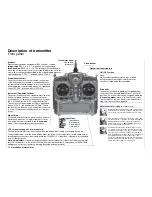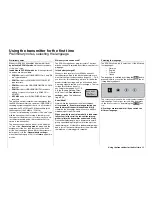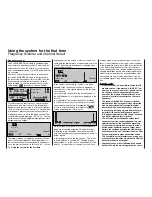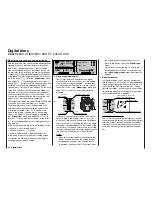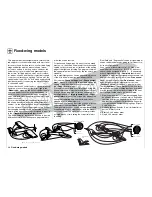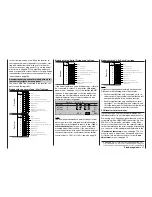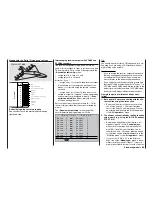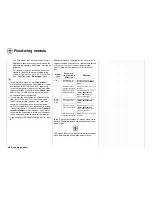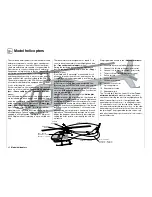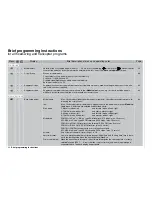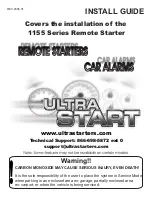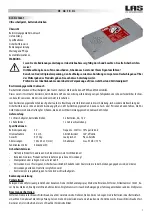
29
D/R
EXPO
D/R
EXPO
D/R
EXPO
5
6
7
8
9
10
11
12
RF
5
6
7
8
9
10
11
12
1
2
3
4
is possible – and indeed likely – that there will be dif-
ferences between the number of the transmitter con-
trol and the number of the subsequent control chan-
nel.
Control channel
There is a point in the signal path where the signal
contains all the information required to control a par-
ticular servo. Whether it emanates directly from a
transmitter control or indirectly via a mixer, we now
describe this as a control channel. This signal is ge-
nerated individually for each servo, and then leaves
the transmitter via the RF module in order to control
the corresponding servo in the model.
Mixers
The signal fl ow chart includes a wide range of mixer
functions. Their purpose is to enable a control func-
tion to branch at the mixer input, so that it can affect
multiple servos. The mixer programs provided by the
software are extremely wide-ranging and versatile.
Please refer to the section of this manual starting on
page 110, which describes the numerous mixer func-
tions in full detail.
Switches (SW)
Earlier we saw that the two-position and three-po-
sition switches provided by the
mx
-24s are able to
move their associated servos to two or three pre-de-
fi ned positions. However, all these switches are also
designed to be used for switching program options,
e. g. for starting and stopping timers, switching mi-
xers on and off, toggling Trainer mode etc.. For this
reason the two three-position switches are also de-
scribed as “SW 5 + 6” and “SW 9 + 10”. The switch
SW 8 – top right, rear – is a self-neutralising unit.
Each switch can be assigned as many functions as
you wish. The linking of several switches in “AND”
or “OR” combinations (see the »
Logical switches
«
menu on page 97) enables them to be used in very
complex superimposed arrangements. Numerous ex-
amples are described later in this manual.
Defi nition of terms
Control function
Control channel
Aer
ial
Ser
v
o
adjustment:
re
v
erse - centre - tr
a
v
el - limit
mx
-24s-Prog
ramme
For example:
Model type
Helicopter type
Control switches
Logical switches
Phase settings
Phase assignment
Non-delayed channels
Wing mixers
Helicopter mixers
Free mixers
MIX active in phase
MIX only channel
Dual mixers
2-position s
witch
3-position s
witch
For switching mixers, auto-
rotation, fl ight phases etc.
Function input
Channel 1
curve
Dual-axis stick unit
Dual-axis stick unit
Transmitter control
(digital button) 5
Transmitter control
(digital button) 6
Transmitter control 7
(3-position switch)
Transmitter control 8
(3-position switch)
Transmitter control 9
(right-hand side-mounted
rotary control)
Free assignment of
transmitter controls 1,
5 … 10 and of all swit-
ches (SW) by software
Stic
k mode 1 … 4
Unrestr
icted tr
ansmitter control assignment, inputs 5 … 12
T
ransmitter contr
ol settings:
offset - control tr
a
v
el - time
T
ransmitter controls
By def
ault tr
ansmitter controls
5 …12 are de-coupled in the
softw
are – (e
xception:
Throttle limiter control)
T
ransmitter control inputs 1 …
4 can be interchanged in the
»
Base setup model
« men
u.
T
ransmitter controls 1 and 5
… 10 can be assigned to in-
puts 5 … 12 in an
y order in
the »
Contr
ol adjust
« men
u.
Mix
er input
Mix
er output
Transmitter control 10
(left-hand side-mounted
rotary control)
Signal fl ow chart
or
Summary of Contents for mx-24s
Page 1: ...1...
Page 19: ...19 For your notes...
Page 35: ...35 For your notes...
Page 41: ...41 41 For your notes...
Page 57: ...57 For your notes...
Page 63: ...63 63 For your notes...
Page 69: ...69 69 For your notes...
Page 85: ...85 85 For your notes...
Page 99: ...99 For your notes...
Page 143: ...143 For your notes...
Page 191: ...191 For your notes...
Page 212: ...212 212 For your notes...
Page 213: ...213 213 For your notes...
Page 214: ...214 For your notes...
Page 216: ...216...






